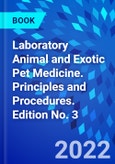Learn the veterinary technician's role in the care of exotic pets and animals used in biomedical research! Laboratory Animal and Exotic Pet Medicine: Principles and Procedures, 3rd Edition helps you gain the knowledge and skills needed to ensure animal health and well-being. It covers animal husbandry, restraint and handling, and diseases, and provides guidelines to key clinical procedures such as blood collection, medication administration, anesthesia, and diagnostic imaging. Research-related information addresses the ethical concerns of exotic pet ownership, as well as the benefits and humane use of animals in research. Written by noted veterinary technology educator Margi Sirois, this text is a must-have resource for all caretakers of lab animals.
- Comprehensive coverage prepares you to work with all types of animals by addressing a wide variety of species including rats, mice, rabbits, guinea pigs, ferrets, hamsters, gerbils, nonhuman primates, amphibians, fish, reptiles, birds, farm animals, and cats and dogs; it also covers topics such as animal species, the laboratory setting, regulatory guidelines, and ethical considerations. - Consistent organization of each species chapter makes it easy to quickly identify similarities and differences among various laboratory animals. - Current information on legal, moral, and ethical issues includes legal requirements, the protocols guiding lab animal use, animal exploitation, and animal rights. - Discussion of specific uses for each species in biomedical research provides a perspective that helps you explain the benefits of animal use in providing high-quality research data. - Technician Notes highlight important points and provide helpful tips to improve your knowledge and skills. - Learning objectives, key points, and chapter review questions make studying easier. - NEW! Comprehensive coverage of poultry includes the increasingly popular backyard chickens, as well as commonly performed procedures and in-depth information on housing, restraint, nutrition, common diseases, diagnostics, and therapeutics. - NEW photographs show the latest technology available in laboratory and exotic animal medicine.
- Comprehensive coverage prepares you to work with all types of animals by addressing a wide variety of species including rats, mice, rabbits, guinea pigs, ferrets, hamsters, gerbils, nonhuman primates, amphibians, fish, reptiles, birds, farm animals, and cats and dogs; it also covers topics such as animal species, the laboratory setting, regulatory guidelines, and ethical considerations. - Consistent organization of each species chapter makes it easy to quickly identify similarities and differences among various laboratory animals. - Current information on legal, moral, and ethical issues includes legal requirements, the protocols guiding lab animal use, animal exploitation, and animal rights. - Discussion of specific uses for each species in biomedical research provides a perspective that helps you explain the benefits of animal use in providing high-quality research data. - Technician Notes highlight important points and provide helpful tips to improve your knowledge and skills. - Learning objectives, key points, and chapter review questions make studying easier. - NEW! Comprehensive coverage of poultry includes the increasingly popular backyard chickens, as well as commonly performed procedures and in-depth information on housing, restraint, nutrition, common diseases, diagnostics, and therapeutics. - NEW photographs show the latest technology available in laboratory and exotic animal medicine.
Table of Contents
PART I: Principles of Laboratory Animal Medicine1. Introduction to Exotic and Laboratory Animal Medicine
2. Exotic Companion Animal Facilities
3. Research Animal Facilities
PART II: Laboratory Animals
4. Birds
5. Reptiles
6. Amphibians
7. Fish
8. Rats and Mice
9. The Rabbit
10. The Guinea Pig
11. The Ferret
12. Gerbils and Hamsters
13. Other Species
14. Nonhuman Primates
15. Wildlife








